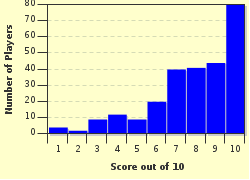Quiz Answer Key and Fun Facts
1. Spiders produce thread from the spinneret glands. On which part of a spider's body are these glands located?
2. Making a web uses up a large amount of a spider's energy. Which particular substance is used in the manufacture of the silky strands of these webs?
3. Web making is a very tiring business. What do some spiders do with the webs in order to re-boost their energy levels?
4. Surprisingly, not all spiders make webs to capture prey, nor anchor webs to fixed objects. How then do these spiders catch their food?
5. How do web spinning spiders initially span large gaps that seem impossible to cross, ie, between two tall trees?
6. What do spiders use as a measurement in making the patterns of a web?
7. Not all spiders wait in the centre of their webs for their prey to come along. Why is this?
8. In traditional medicine from the days of yore, and even today in some areas, to what use are spider webs put?
9. Spider webs have been used in which artistic pursuit?
10. What are spiders occasionally known to do together in groups?
Source: Author
Creedy
This quiz was reviewed by FunTrivia editor
crisw before going online.
Any errors found in FunTrivia content are routinely corrected through our feedback system.

